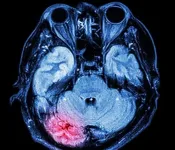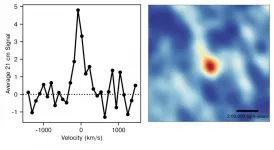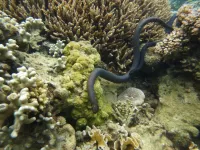A targeted treatment for IgA nephropathy at last?
Iptacopan, an oral, alternative complement pathway inhibitor of Factor B, could provide the first therapy targeted at one of the key drivers of IgAN
2021-06-07
(Press-News.org) IgA nephropathy (IgAN) is a chronic kidney disease occurring in young adults and is one of the most common reasons for kidney transplantation in this age group. IgAN is the most common form of glomerulonephritis (GN), i.e., immunologically induced inflammation of the renal glomeruli. It is characterized by glomerular deposition of immune complexes containing immunoglobulin A (IgA), and by a complex inflammatory response and progressive loss of kidney function. For many decades, IgAN has therefore been treated with anti-inflammatory or strong immunosuppressive agents. However, the STOP-IgAN study and its ten-year follow-up [2, 3] showed that the addition of immunosuppressive therapy to optimal supportive therapy (strict blood pressure control, proteinuria treatment with RAS blockers, dietary and lifestyle measures), has no additional benefit: During the follow-up period, approximately half of all patients reached the primary combined endpoint (progressive loss of renal function > 40%, dialysis requirement or mortality). However, immunosuppression increased the incidence of adverse effects, especially infections. The use of immunosuppressants in IgAN has since been increasingly questioned by experts and should only be applied to rapid-progressive courses. Long-term outcomes are generally unfavorable, so targeted therapy is still urgently needed in addition to optimization of supportive therapy.
It is now known that overactivity of the alternative complement signaling pathway of the immune system plays a role in the pathogenesis of IgAN, thereby increasing the chronic inflammation. Targeted inhibition of this signaling pathway is thus a logical therapeutic approach.
Iptacopan is an oral, highly selective inhibitor of complement factor B and the alternative complement signaling pathway, and has now been investigated in a randomized, double-blind placebo-controlled Phase II clinical trial. In Part 1, 46 IgAN patients received three different doses of iptacopan or placebo for 90 days. A further 66 patients were then treated in Part 2 with four doses of iptacopan or placebo for 180 days. The primary endpoint was the dose-response relationship in the improvement of proteinuria (as a 24-hr urine protein/creatinine ratio). All 112 patients have now been evaluated together (day 90). Secondary endpoints were safety and tolerability, as well as eGFR and biomarkers of the alternative complement signaling pathway. Five groups were compared: iptacopan 10mg (n=20); 50mg (n=19); 100mg (n=22); 200mg (n=26) and placebo (n=25). Four patients (3.6%) had discontinued treatment due to side effects (two in the placebo group and one in the Verum group) or to protocol errors (in one case).
The analysis showed a statistically significant dose-response effect of iptacopan versus placebo (p=0.038), with a 23% decrease in proteinuria under 200 mg iptacopan versus placebo at 90 days. Renal function (eGFR) showed a trend to stabilization, and biomarkers also improved (functional serum complement activity, concentration of complement factor Bb, and urinary excretion of soluble C5b-9 were measured). Side effects were mild (92%) to moderate (8%); there were no serious adverse effects. The most common side effects were headache (11.6%), back pain (6.3%), diarrhea (6.3%), vomiting (6.3%), but not related to the dose taken.
'This is the first study to report the safety and efficacy of targeted alternative complement pathway inhibition in IgAN patients, with the results showing a significant dose-dependent reduction in proteinuria and a trend to eGFR stabilization,' comments Dr Barratt. 'Iptacopan was also well tolerated and resulted in inhibition of various biomarkers of alternative pathway activity, supporting its further evaluation in the ongoing Phase III (APPLAUSE-IgAN) trial.'
INFORMATION:
[1] 2457 Jonathan Barratt, Leicester, UK. Interim Analysis of a Phase 2 Dose ranging Study to investigate the Efficacy and Safety of Iptacopan in Primary IgA Nephropathy.
[2] Rauen T, Wied S, Fitzner C et al. After ten years of follow-up, no difference between supportive care plus immunosuppression and supportive care alone in IgA nephropathy. Kidney Int 2020 Oct; 98 (4): 1044-1052
[3] Rauen T, Eitner F, Fitzner C et al. Intensive Supportive Care plus Immunosuppression in IgA Nephropathy. N Engl J Med 2015; 373: 2225-36
About ERA-EDTA
With more than 7,000 active members, the ERA-EDTA is one of the biggest nephrology associations worldwide leading European nephrology and one of the most important European Medical Associations. It organizes annual congresses and other educational and scientific activities. ERA-EDTA also collects data, and performs epidemiological studies through its Registry. The Society supports fellowships and educational/research projects through its committees and working groups. Its publications are NDT, CKJ (Open Access journal), and the online educational portal NEP.
The 59th Congress will take place in May 19-22, 2022, both virtual and live in Paris (France).
Website: http://www.era-edta.org About ERA-EDTA
ELSE PRESS RELEASES FROM THIS DATE:
2021-06-07
Wider clean chemistry applications of the extraordinary Vortex Fluidic Device - invented by Flinders University's Professor Colin Raston - are likely in the wake of new research that has been published outlining the seemingly endless possible uses.
The defining paper on understanding fluid flow in the Vortex Fluidic Device has just been comprehensively explained in an article published in Nanoscale Advances (DOI: 10.1039/D1NA00195G).
This took more than 100,000 experiments to work out - and Professor Raston hopes this publication will encourage more researchers to embrace the VFD and explore yet more innovative applications for this ingenious device.
"How fluid flows is one of the grand challenges of science," says Professor Raston. "What we have been ...
2021-06-07
A world-first international study led by the University of South Australia has identified a new drug to stop athletes developing dementia after sustaining repeated head injuries in their career.
The link between concussion and neurogenerative diseases is well established, but new research findings could halt the progression of chronic traumatic encephalopathy (CTE) in sportspeople who sustain repeated blows to the head.
CTE is a progressive and fatal brain disease associated with the accumulation of a protein known as hyperphosphorylated tau which affects cognition and behaviour.
In a paper published in Scientific Reports, ...
2021-06-07
LA JOLLA, CALIF. - June 7, 2021 - A preclinical study led by scientists at Sanford Burnham Prebys has established that AAV8-TNAP-D10--a gene therapy that replaces a key enzyme found in bone--may be a safe and effective single-dose treatment for hypophosphatasia (HPP). The study, published in the Journal of Bone and Mineral Research and performed in a murine model of the disease, further supports advancing the therapy toward human clinical trials.
"This is the most promising gene therapy study to date demonstrating a successful increase in life span, and improvement ...
2021-06-07
Monash University researchers have provided a fundamental advance regarding how T cells become activated when encountering pathogens such as viruses.
The recent study published in Science, co-led by Professor Nicole La Gruta, Professor Jamie Rossjohn and Professor Stephanie Gras with first author Dr Pirooz Zareie from the Monash Biomedicine Discovery Institute, have found that T Cells need to recognise pathogens in a particular orientation in order to receive a strong activating signal.
T cells play a key role in the immune system by eliminating invading pathogens, such as viruses, and it is crucial to understand ...
2021-06-07
When we inhale isolated coronavirus particles, more than 65% reach the deepest region of our lungs where damage to cells can lead to low blood oxygen levels, new research has discovered, and more of these aerosols reach the right lung than the left.
Lead author of the study Dr Saidul Islam, from the University of Technology Sydney, said while previous research has revealed how virus aerosols travel through the upper airways including the nose, mouth and throat - this study was the first to examine how they flow through the lower lungs.
"Our ...
2021-06-07
Finding the hypothetical particle axion could mean finding out for the first time what happened in the Universe a second after the Big Bang, suggests a new study published in Physical Review D on June 7.
How far back into the Universe's past can we look today? In the electromagnetic spectrum, observations of the Cosmic Microwave Background -- commonly referred to as the CMB -- allow us to see back almost 14 billion years to when the Universe cooled sufficiently for protons and electrons to combine and form neutral hydrogen. The CMB has taught us an inordinate amount about the evolution of the cosmos, but photons in the CMB were released 400,000 years after the Big Bang making it extremely challenging to learn about the history of ...
2021-06-07
TAMPA, Fla. (June 4, 2021) — Type 1 diabetes (T1D) is an autoimmune disease in which a misdirected immune system gradually destroys healthy pancreatic islet β cells, resulting in a lack of insulin. The exact cause of T1D remains unknown. However, β cell-reactive autoantibodies can be detected in circulating blood months to years before diagnosis, raising the possibility of intervening to stop or delay T1D before children develop the disease.
Monitoring the number, type, and concentration of autoantibodies appearing in the blood can help predict the long-term risk of progression from autoimmunity to symptomatic T1D.
Now new findings suggest that measuring how patterns ...
2021-06-07
A research team from the University of Copenhagen and University of Helsinki demonstrates it is possible to predict individual preferences based on how a person's brain responses match up to others. This could potentially be used to provide individually-tailored media content -- and perhaps even to enlighten us about ourselves.
We have become accustomed to online algorithms trying to guess our preferences for everything from movies and music to news and shopping. This is based not only on what we have searched for, looked at, or listened to, but also on how these activities compare to others. Collaborative filtering, as the technique is called, uses hidden ...
2021-06-07
A team of astronomers from the National Centre for Radio Astrophysics (NCRA-TIFR) in Pune, and the Raman Research Institute (RRI), in Bangalore, has used the Giant Metrewave Radio Telescope (GMRT) to measure the atomic hydrogen gas content of galaxies 9 billion years ago, in the young universe. This is the earliest epoch in the universe for which there is a measurement of the atomic hydrogen content of galaxies. The new result is a crucial confirmation of the group's earlier result, where they had measured the atomic hydrogen content of galaxies 8 billion years ago, and pushes our understanding of galaxies to even earlier in the universe. ...
2021-06-07
Decades of research has revealed the remarkable morphological adaptations of sea snakes to aquatic life, which include paddle-shaped tails, salt-excreting glands, and the ability to breathe through their skin.
In a new study published in Biological Journal of the Linnean Society, researchers at the University of Adelaide detail the enlarged touch receptors that evolved in male turtle-headed sea snakes (Emydocephalus annulatus), to help them locate and court females in aquatic environments.
Lead author, Jenna Crowe-Riddell, PhD graduate at the University of Adelaide's School of Biological Sciences, says on land, snakes use tongue-flicking ...
LAST 30 PRESS RELEASES:
[Press-News.org] A targeted treatment for IgA nephropathy at last?
Iptacopan, an oral, alternative complement pathway inhibitor of Factor B, could provide the first therapy targeted at one of the key drivers of IgAN






